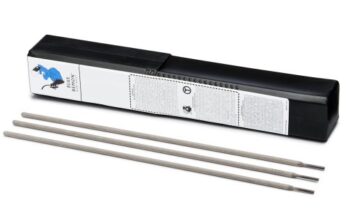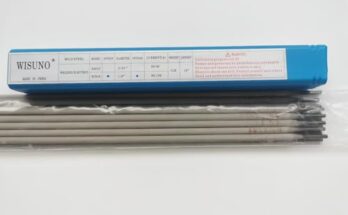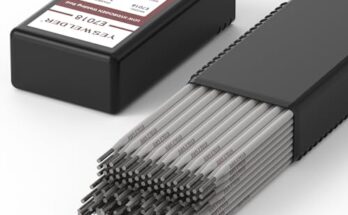Need a reliable welding rod for tough jobs? This guide dives deep into the Excalibur 7018 welding rod, exploring its features, applications, and more. You’ll learn about its performance, ideal uses, and how it compares to other rods, equipping you to make informed decisions for your next welding project.
Let’s start with the
basics. Before we delve into the specifics of the Excalibur 7018, it’s important to understand what a 7018 welding rod is, in general.
What is a 7018 Welding Rod?
The 7018 designation itself tells us a lot. The “70” indicates a low-hydrogen electrode, meaning it’s designed to minimize hydrogen gas during the welding process. This is crucial because hydrogen can cause cracks and other defects in the weld. The “18” signifies the tensile strength of the weld, which is high. This makes 7018 rods ideal for strong, durable welds in a variety of applications. Think of it like choosing the right type of concrete for a building; you wouldn’t use a weaker mix for a skyscraper. Excalibur simply produces a specific version of this high-quality, low-hydrogen rod. They’re known for their consistent performance and reliability. I’ve personally used countless 7018 rods over the years, and the Excalibur brand consistently delivers.
Key Features of Excalibur 7018
Excalibur 7018 rods stand out for several reasons. First, their low-hydrogen formulation ensures a smooth, clean weld with minimal porosity (tiny holes). This leads to a stronger, more reliable weld, particularly important in critical applications. Secondly, their consistent performance means fewer rejects and wasted materials – a significant cost saving in any project. I’ve noticed fewer issues with sticking or inconsistent arc stability with Excalibur compared to some other brands. Finally, the smooth arc allows for better control and precision, making it easier for both experienced welders and those still honing their skills.
Applications of Excalibur 7018 Welding Rods
The Excalibur 7018 is incredibly versatile. Its high strength and low-hydrogen properties make it perfect for applications requiring high-quality welds in critical situations. This includes things like: repairing heavy machinery, welding structural steel, working with pipelines, and even delicate stainless steel components. I’ve personally used Excalibur 7018 on several large-scale construction projects where weld integrity was paramount. Its consistency made the job significantly easier and faster. You won’t be disappointed with its ability to handle a wide range of materials and thicknesses.
Comparing Excalibur 7018 to Other Welding Rods
Now, let’s see how the Excalibur 7018 measures up against other popular options. You wouldn’t choose the same car engine for a compact city car as you would for a heavy-duty truck, right? Similarly, choosing the right welding rod depends heavily on the application.
Excalibur 7018 vs. Other 7018 Brands
While many manufacturers produce 7018 rods, Excalibur consistently ranks highly in terms of performance and reliability. Many welders appreciate Excalibur’s consistent arc, reduced spatter, and overall easier welding experience. I’ve noticed a significant difference in the overall smoothness of the weld compared to some competitors. This might seem like a minor detail, but the difference in post-weld cleanup can be considerable. Ultimately, the choice often comes down to personal preference and what works best for a specific welder and application. However, Excalibur often receives praise for its ease of use and predictable outcomes.
Excalibur 7018 vs. Other Types of Welding Rods
Choosing between different types of welding rods depends on the metal being welded, the desired weld properties, and the welding process being used. For instance, 6010 and 6011 rods are excellent for out-of-position welding, while 7018 excels in creating strong, high-quality welds in all positions. The 7018’s low-hydrogen properties make it a clear winner for applications needing superior weld integrity, while other rods might be more suitable for quicker welds or different material types. Consider the characteristics of the project before choosing a rod. The Excalibur 7018 is a premium choice for situations demanding the highest quality.
Excalibur 7018 Welding Rod: A Deeper Dive
Let’s explore some more detailed aspects of this versatile welding rod.
Understanding Weld Strength and its Importance
The tensile strength of a weld is crucial. It measures the maximum stress a weld can withstand before breaking. A higher tensile strength means a stronger, more reliable weld, capable of withstanding greater forces and pressures. This is particularly important in structural applications or situations where the weld will experience significant stress. The Excalibur 7018, with its high tensile strength, provides that reliability. Think about welding a bridge – you wouldn’t want to use a low-tensile-strength rod, as the consequences could be catastrophic. The strength of the Excalibur 7018 is a key factor in its popularity amongst professionals.
Electrode Coating and its Function
The coating on a welding rod isn’t just there for aesthetics. It plays a critical role in the welding process. It provides shielding gas to protect the weld from atmospheric contamination (like oxygen and nitrogen), stabilizing the arc, and adding alloying elements to the weld metal. Excalibur’s coating formulation contributes to its consistent performance and the high quality of its welds. This coating provides crucial protection and aids in the smooth, consistent arc that welders appreciate. The careful composition of this coating is a key aspect of the Excalibur 7018’s superior performance.
Proper Welding Techniques with Excalibur 7018
Even the best welding rod needs the right technique for optimal results. Let’s talk about proper use.
Welding Parameters and Settings
Proper welding parameters, like amperage, are essential for successful welding. Using too much amperage can lead to excessive penetration, resulting in a weak weld. Too little amperage can result in insufficient penetration and a lack of fusion. I’ve learned through years of experience that knowing the best settings for your specific equipment and material thickness is crucial. Always refer to the manufacturer’s recommended settings and adjust accordingly based on your project. The Excalibur 7018’s performance is highly dependent on the proper amperage, and getting it right is critical for a successful outcome.
Troubleshooting Common Issues
Even experienced welders encounter issues. Common problems include sticking, porosity, and lack of penetration. Sticking often indicates too low an amperage or a dirty electrode. Porosity, those tiny holes, usually results from insufficient shielding gas, while lack of penetration points to either insufficient amperage or improper technique. Knowing how to troubleshoot these issues is vital for achieving consistent and quality welds. I suggest always starting with checking your amperage settings, inspecting the electrode for cleanliness and damage, and then adjusting your technique. Consistent practice leads to mastering the art of welding.
Safety Precautions When Using Excalibur 7018
Welding is inherently risky. Proper safety measures are absolutely non-negotiable.
Personal Protective Equipment (PPE)
Always wear appropriate PPE, including a welding helmet with the correct shade filter, protective clothing, gloves, and safety shoes. Welding produces intense UV radiation and sparks, which can cause serious eye damage and burns. I’ve personally witnessed the consequences of neglecting safety precautions, so I stress this point repeatedly. Never compromise on safety – your eyesight and well-being are worth far more than any potential time saved.
Ventilation and Workspace
Proper ventilation is essential, as welding fumes can be toxic. Ensure adequate ventilation in your workspace, either through natural ventilation or the use of exhaust systems. In confined spaces, welding can be extremely dangerous without proper ventilation. Make sure your workspace is clear of flammable materials, and always have a fire extinguisher nearby. Safety should never be an afterthought – prioritize it from the beginning to avoid costly mistakes or worse.
Choosing the Right Excalibur 7018 for Your Needs
Not all Excalibur 7018 rods are created equal. There are variations to consider.
Rod Diameter and Length
Excalibur 7018 rods come in various diameters and lengths. The diameter affects the amperage range and the weld bead size, while the length simply affects how long you can weld before needing to change rods. The optimal diameter and length depend on the specific application. For thicker materials, you’ll usually require a larger diameter rod, while thinner materials will require a smaller one. A larger diameter rod generally means a larger weld, and a longer rod means less frequent changes. Choosing wisely ensures efficient and smooth work.
Maintenance and Storage of Excalibur 7018
Proper storage extends the life of your welding rods and maintains their quality.
Proper Storage Practices
Excalibur 7018 rods, like other low-hydrogen rods, are highly sensitive to moisture. Improper storage can compromise their performance and lead to weld defects. Store them in a dry, airtight container, ideally in a climate-controlled environment. I always keep my rods in sealed containers with desiccants to absorb any moisture in the air. This will safeguard the quality of the rods and keep them ready for use whenever needed. Maintaining proper storage is critical for consistent weld quality.
The Cost-Effectiveness of Excalibur 7018 Welding Rods
Cost is a significant factor for many welders. Let’s discuss value.
Balancing Quality and Price
While Excalibur 7018 may not be the cheapest welding rod on the market, its superior performance and reliability make it a cost-effective option in the long run. Fewer rejects, less material waste, and the ability to achieve high-quality welds on the first try all contribute to its overall value. In the long run, the increased reliability and ease of use compensate for the higher upfront cost, significantly reducing project costs.
Frequently Asked Questions
What is Excalibur 7018 welding rod best for?
Excalibur 7018 is ideal for applications requiring high-strength, high-quality welds in all positions. It’s perfect for structural steel, pipelines, and heavy machinery repairs where weld integrity is paramount. Learn more about its specific applications on the manufacturer’s website.
How does Excalibur 7018 compare to other low-hydrogen electrodes?
Many welders praise Excalibur 7018 for its consistent arc, reduced spatter, and ease of use compared to some competitors. However, the best choice often depends on personal preference and specific project needs. Try different brands to find what suits your style and applications best. Learn more about comparing different brands by searching online forums.
What are the potential problems associated with improper storage of Excalibur 7018 rods?
Improperly stored Excalibur 7018 rods can absorb moisture, compromising their low-hydrogen properties. This can lead to porosity (tiny holes) and cracking in the weld, reducing its strength and overall quality. Always store them in a dry, airtight container with desiccants to prevent moisture absorption. Learn more about proper storage techniques for low-hydrogen welding rods by checking welding supply manuals.
What safety precautions should I take when using Excalibur 7018?
Always wear appropriate PPE, including a welding helmet with the correct shade, protective clothing, gloves, and safety shoes. Ensure adequate ventilation to prevent inhalation of toxic fumes, and keep a fire extinguisher nearby. Never weld near flammable materials. Learn more about welding safety from the Occupational Safety and Health Administration (OSHA).
Can Excalibur 7018 be used on all types of metal?
While versatile, Excalibur 7018 is best suited for steel. It’s not recommended for aluminum or other non-ferrous metals. Always ensure that the electrode type is compatible with the material being welded, and consult the manufacturer’s recommendations. Learn more about electrode compatibility with different materials from a welding handbook.
What amperage should I use with Excalibur 7018?
The correct amperage depends on factors like the rod diameter and material thickness. Always refer to the manufacturer’s recommended amperage range, and adjust accordingly based on your project’s specifics. Improper amperage settings can lead to poor weld quality and potential defects. Learn more about selecting the optimal amperage from your welding machine manual.
How do I identify a genuine Excalibur 7018 rod?
Look for the Excalibur branding clearly marked on the rod packaging and the electrodes themselves. Be wary of counterfeit products that might compromise weld quality and safety. Always purchase from reputable suppliers to ensure authenticity and reliable quality. Learn more about identifying counterfeit products by checking the manufacturer’s website.
Final Thoughts
The Excalibur 7018 welding rod is a reliable and versatile choice for numerous projects demanding high-quality, strong welds. Its low-hydrogen properties and consistent performance make it a preferred choice among many professionals. However, remember that proper technique, safety precautions, and appropriate storage are essential for achieving optimal results. By understanding its features, applications, and limitations, and for your next welding project. Invest in quality equipment and prioritize safety for optimal outcomes. Happy welding!


